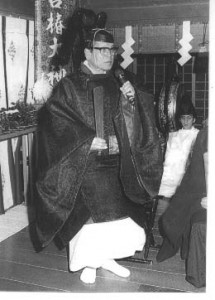‘Kami no Michi; The way of the Kami’ by Yukitaka Yamamoto USA: Tsubaki
America, 1987 124 pages, small size. ISBN 1880656663. Second hand about $10.00
This autobiography by the 96th head of Tsubaki Jinja is of interest because of his vital role in the spread of Shinto to America. Though out of print, it is available online:
http://www.tsubakishrine.org/kaminomichi/index.html
The account tells of a remarkable life. Though Yamamoto was not brought up to be a priest, he assumed leadership of the ancient shrine after the death of his elder brother and twin. This followed his involvement in WW2: of the 2,200 men in his mission, only 12 survived. When he took over the ancient Tsubaki shrine, it was in bad shape. At a time when he could not afford a return fare to Tokyo, he embarked on raising Y150 million for reconstruction. Miraculously he succeeded. Years of devotion and the practice of misogi brought him to
realisation of deep truths. One was a desire to further harmony with others, including his former enemy the US. This was fired by a belief that Izanagi and Izanami did not create just Japan, but the world at large. Amongst the principles he outlines is Kannagara – acting in communion with nature – and Sanmi-Sangen, based on a three-fold understanding of life. He also stresses the practice of misogi and daily offerings to the kamidana. A foreword by Stuart Picken pays tribute to a charismatic man with the gift of second sight who ‘saw’ the death of both his elder brother and twin.
Summary: Valuable for those concerned with the spread of Shinto overseas.


Rev. Barrish has informed me that hard copies of the booklet are in fact now available through his shrine, Tsubaki Grand Shrine of America. The shrine also has copies of The Meaning of Shinto.
I was really interested to read an account of World War 2 from the Japanese perspective. As an American, I’d never read anything like it before. Interesting, and frightening. Rev. Yamamoto was clearly a truly driven, dedicated person to do half of the things he did and his words about them could inspire anyone.
The book’s focus on Shinto seemed to be the opening of Shinto to people of other faiths, and might not be as interesting to some as other resources more directly about Shinto are. That being said, I enjoyed reading it.